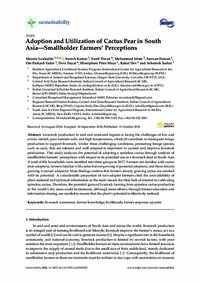Adoption and Utilization of Cactus Pear in South Asia—Smallholder Farmers’ Perceptions

Authors:
Livestock production in arid and semi-arid regions is facing the challenges of low and erratic rainfall, poor nutrient soils, and high temperatures, which all contribute to inadequate forage production to support livestock. Under these challenging conditions, promoting forage species, such as cacti, that are tolerant and well adapted is important to sustain and improve livestock production. This study analyzes the potential of adopting a spineless cactus through analysis of smallholder farmers’ perceptions with respect to its potential use as a livestock feed in South Asia. A total of 456 households were stratified into three groups in 2017: Farmers not familiar with cactus (non-adopters), farmers familiar with cactus but not growing it (potential adopters), and those already growing it (actual adopters). Main findings confirm that farmers already growing cactus are satisfied with its potential. A considerable proportion of non-adopter farmers cited the unavailability of plant material and technical information as the main reason for their lack of interest in cultivating spineless cactus. Therefore, the potential gains of livestock farming from spineless cactus production in the world’s dry areas could be immense, although more efforts, through farmer education and information sharing, are needed to ensure that the plant’s potential is effectively realized.
